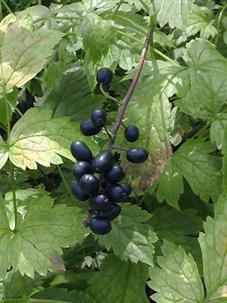In group landings, especially in shaded areas, the Voronets look very good. The plant, inconspicuous during flowering, acquires a decorative look closer to autumn, when it is covered with shiny bright red, white or black berries.
Plant description
This is a perennial, reaching a height of up to 1 meter, found mainly in mixed or coniferous forests, in humid valleys. Its large ternary dissected leaves have a rich green color and form lush curtains. In June, small white flowers appear inconspicuous in appearance on the plant. Voronets refers to plants that are spectacular in their fruits.
In early August, it is decorated with brushes of large glossy berries. In favorable conditions, up to several tens of brushes can be on one bush. The fruits of Vorontsov are poisonous.
Kinds
In Russia, 3 species of this plant grow.
- Red-fruited Voronets. Prefers slightly acidic nutrient and moist soils. Branching leafy stems up to 70 cm high form beautiful bushes. The fruits are distinguished by bright red color, less often white and abundant fruiting. It is more common in the European and Asian parts of our country, in the forest zone. Voronets is red frost-resistant; it can winter well without shelter. Looks great in group landings created in shaded places.
- Voronets are pointed. It is distinguished by wide triangular leaves with a pointed tip, sometimes reaching up to 50 cm in length. Pea-sized fruits are glossy black.
- Voronets are spiky, or, as they call it, Voronets spiky. This species is most common. The high stems of this plant are smooth, covered with brown scales at the base. Saturated black seed multi-seed fruits appear in August-September.
Breeding
Gardeners use, as a rule, a vegetative method when propagating Vorontsov. It’s best to do this early spring. It is not recommended to transplant the plant too often, because the adaptation period after transplantation lasts a very long time. And only the spiky Voronets is a plant that has weak vegetative propagation. Therefore, it is mainly propagated by seeds that require pre-sowing stratification at a temperature of 1 to 3 degrees for three months. Grow seedlings in a room where it is warm enough. In nature, the plant also mainly propagates by seeds. Seed dispersal is facilitated by birds and many animals. Seedlings develop very slowly - only 2 years after sowing, they begin to germinate. Flowering begins only after 3-4 years.
Growing conditions and care
Voronets - unpretentious plant. It is important for him to have fertile and moist soil, but on a poor in composition and drying soil it will grow in the same way, only maybe the development process will go a little slower.
In more favorable conditions, the plant will grow faster and will please with abundant fruiting. For it, acidic loose soils, well moistened and rich in
nutrients, are preferred
. The root system of the plant is shallow, so other plantings from the neighborhood with it do not suffer. Voronets does not require anti-aging division, transplantation, but if such a need arises, transplanting it is not difficult.
Adult plants do not need the close attention of a gardener, except for watering in the dry period. If they are located near trees and shrubs, then fallen leaves, decaying, serve as a supplier of nutrients. Young, newly planted plants must be weeded, regularly watered and mulch the soil near them. Voronets have frost resistance, therefore tolerates winter well, without requiring shelter.
Healing properties
Despite the fact that all parts of the Vorontsian are poisonous in themselves, its therapeutic effect on the human body has long been known. It is important to observe the necessary proportions, so as not to cause poisoning, which may be accompanied by nausea, vomiting and blurred consciousness. Due to the presence of a large number of alkaloids, vitamin C, trans-aconitic acid, saponins and fatty oils in this plant, it is used to treat diseases of the cardiovascular and central nervous systems, with increased excitability and general weakness of the body. Voronets is a plant known for its ability to also normalize blood pressure, improve sleep, relax intestinal muscles, etc. There are results on the treatment of such a disease as inoperable stomach cancer. Almost all parts of this plant possess healing properties.

The root helps people with asthma, and it is also used to get rid of discomfort during menopause, delayed menstruation, pulmonary tuberculosis, and skin problems. A decoction of it is able to relieve toothache. The fruits and leaves of the plant are recommended for the treatment of gynecological diseases, stomach and intestinal ulcers, and as an antitumor agent. The leaves of Vorontsov are used as a poultice for skin abscesses.
In order for the therapeutic effect of Vorontsov to be more effective, it is necessary to properly harvest certain parts of this plant. It is recommended to collect grass in May or June. It is necessary to dry the prepared raw materials in the shade under a canopy, avoiding direct sunlight. The roots can be harvested both in early spring and autumn. Rhizomes are dug up and thoroughly washed from the ground and damaged parts, after which they are dried in a special dryer at a temperature of no more than 40 ° C.
It is necessary to use Voronets as a therapeutic agent very carefully, given that this plant is poisonous and can cause poisoning even in dried form.
Contraindications
The use of drugs based on Vorontsov is contraindicated in pregnant and lactating women, young children. Overuse of these drugs can cause skin ulcers, mucosal damage, vomiting, and respiratory failure.
In landscape design, Voronets is often used. Photos of compositions featuring this plant show how successful a partner it is for many garden crops. At the end of summer, when most of the plants finished the flowering period, the bright fruits of Vorontsov delight the eye with their beauty, being a decoration of the garden and adding colors to the flower beds.